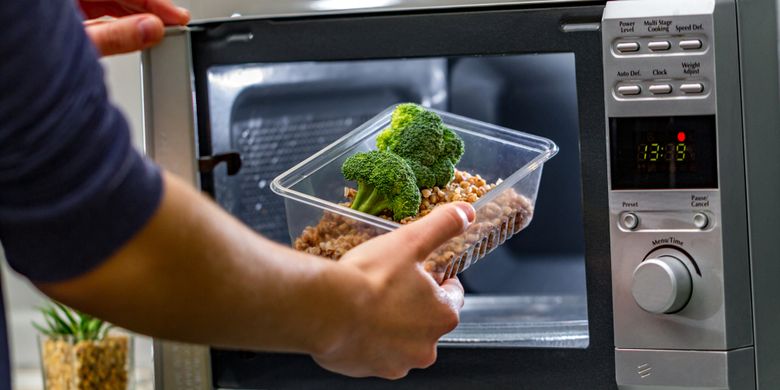
Did you know that the US Food and Drug Administration (FDA) regulates microwave ovens? Microwave oven manufacturers must certify that their products comply with safety standards created and applied by the FDA to protect public health.
Microwave ovens are generally safe when used correctly. However, some people have suffered burns, and in less frequent cases, other injuries caused by microwave radiation, especially in cases involving improper use or maintenance. For this reason, ovens should always be used (read below for recommendations) and maintained according to the recommendations in the user manuals.
How microwave ovens work
First of all, you should know that microwaves – the waves produced by these ovens – are a type of electromagnetic radiation. These waves make the water molecules in food vibrate. These vibrations, in turn, produce the heat that cooks the food.
The waves are generated in a vacuum tube called a magnetron inside the furnace. They are reflected in the metal interior of the furnace; they can pass through glass, paper, plastic and other similar materials; and they are absorbed by food.
Microwaves are a type of non-ionizing radiation. They do not have the same risks as X-rays or other types of ionizing radiation (ionizing radiation is a more energetic type of radiation that can cause changes in human cells).
Injury Hazards and Background on Microwave Ovens
Most microwave oven-related injuries are the result of heat burns from contact with hot containers, overheated food, or liquid explosions.
Most injuries are unrelated to radiation. That said, there have been a very small number of cases where radiation injuries have occurred due to unusual circumstances or improper maintenance.
In general, these radiation injuries occur as a result of exposure to high amounts of microwave radiation that escapes through gaps in the seals of microwave ovens. However, FDA regulations stipulate that microwave ovens must be designed in a way that prevents these radiation leaks. They did Microwave radiation testing. In fact, manufacturers must certify that their microwave ovens meet FDA safety standards. These standards require radiation emitted by furnaces to be well below levels known to cause injury.
While some people have expressed concern that microwave ovens may interfere with certain electrical pacemakers, current pacemakers are designed to be interference proof. Ask your healthcare provider if you have any concerns.
Security advice
Follow the manufacturer’s instructions for use . The instructions in the user manual indicate safety precautions and recommended use procedures. For example, some microwave ovens should not be used when empty. In addition, water or liquids should not be heated for longer than recommended and indicated by the manufacturer.
Use microwave safe containers. Use containers made especially for use in microwave ovens. Generally, you shouldn’t use metal containers or aluminum foil as these materials reflect microwaves and cause food to heat unevenly and can also damage the oven. Also, you shouldn’t use some plastic containers because hot food could melt them. The FDA recommends using glass, ceramic, and plastic containers designed for use in microwave ovens.
Avoid overheating the water. “Superheated” water is water that has been heated above the boiling point, but without the characteristic signs of boiling. If you use a microwave oven to heat water above the boiling point in a clean container, the slightest disturbance or slight movement can cause the water to explode violently and jump out of the container. Serious skin burns or injuries from boiling water have been reported to people’s face and hands as a result of this phenomenon.
Adding ingredients such as instant coffee or sugar to the water before heating greatly reduces the risk of hot water rash. Remember to also follow the manufacturer’s instructions when scheduling.
Rule out any leaks. Unless the door hinges, latch, or seals are damaged, the risk of radiation leaks from these ovens is minimal and should not be a cause for concern. The FDA recommends inspecting the oven to rule out these problems. The agency also recommends not using an oven if the door does not close properly or is bent, warped, or damaged in any way.
Do not use ovens that appear to work with the door open . The FDA monitors these appliances for radiation-related safety issues and has received a growing number of reports about microwave ovens that appear to stay on — and operate — with the door open. If this happens, the FDA recommends that you stop using the microwave oven immediately.
“Sometimes a fault in the door close switch can allow the fan, light and / or turntable to operate with the door open. However, the redundant safety systems in microwave ovens are designed to prevent the magnetron from emitting microwaves, ”explains Ting Song, Ph.D., an FDA biomedical magnetic resonance and electronics engineer. “When redundant safety systems are operating normally, the magnetron will not go live. However, given that each oven has a different design, consumers cannot be 100 percent sure that microwave radiation is not emitted in these cases. “
How to report a problem
In FDA experience, most microwave ovens that are tested have very small or undetectable radiation leaks.
However, if your microwave oven shows any signs of leakage or damage, or if you suspect that it may have a radiation problem, you can contact the oven manufacturer. Manufacturers are required to report various problems to the FDA, including microwave oven defects, non-compliance with federal regulations, and incidents of accidental radiation exposure.
